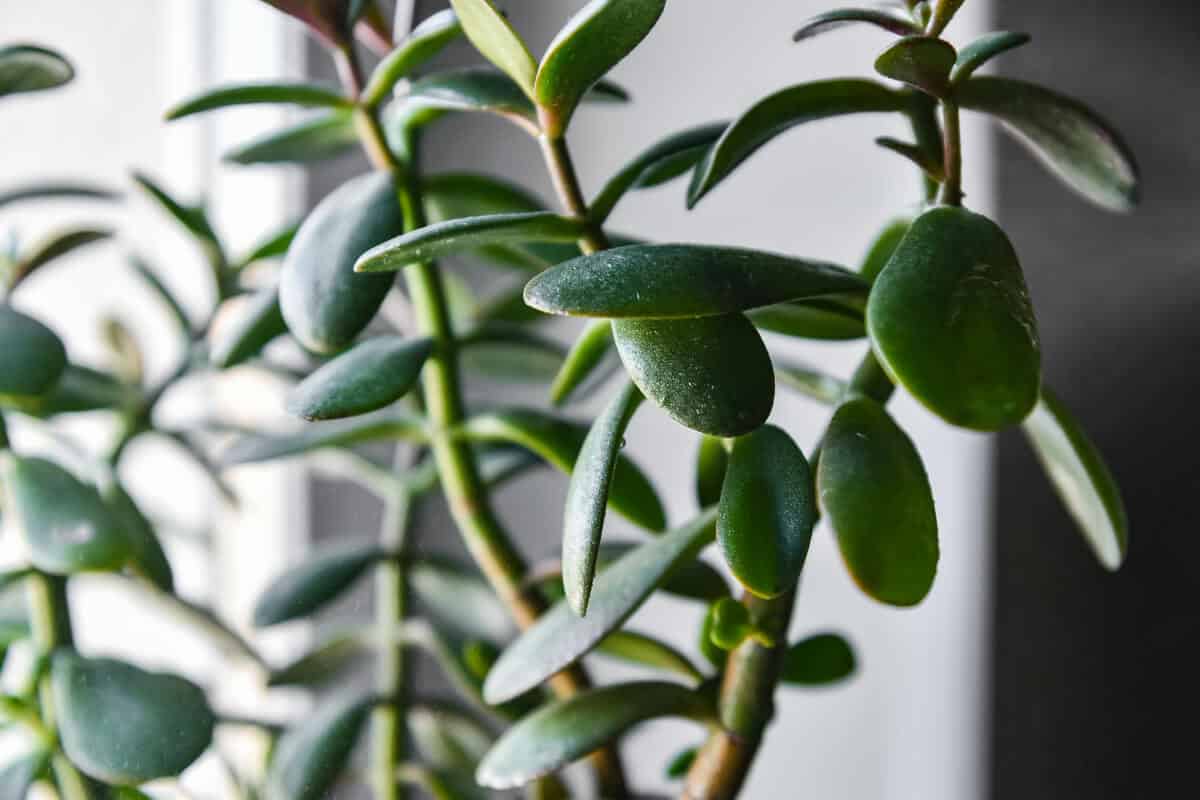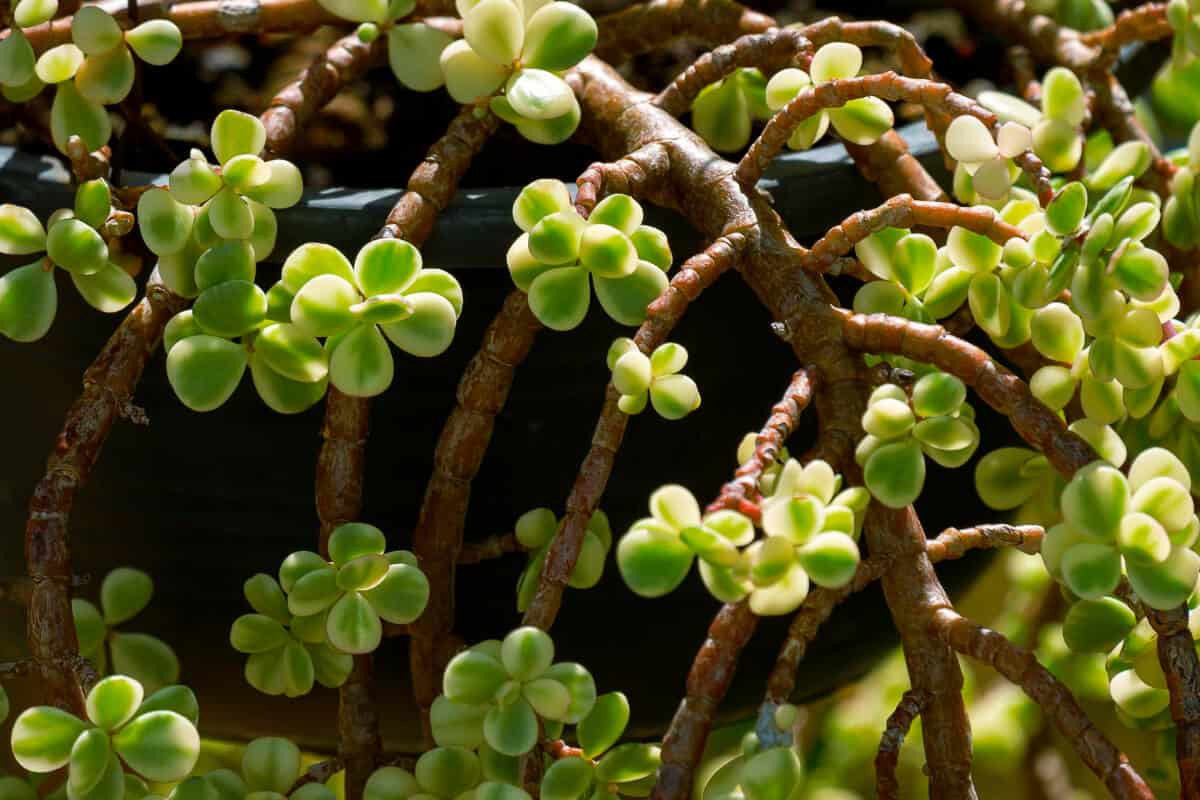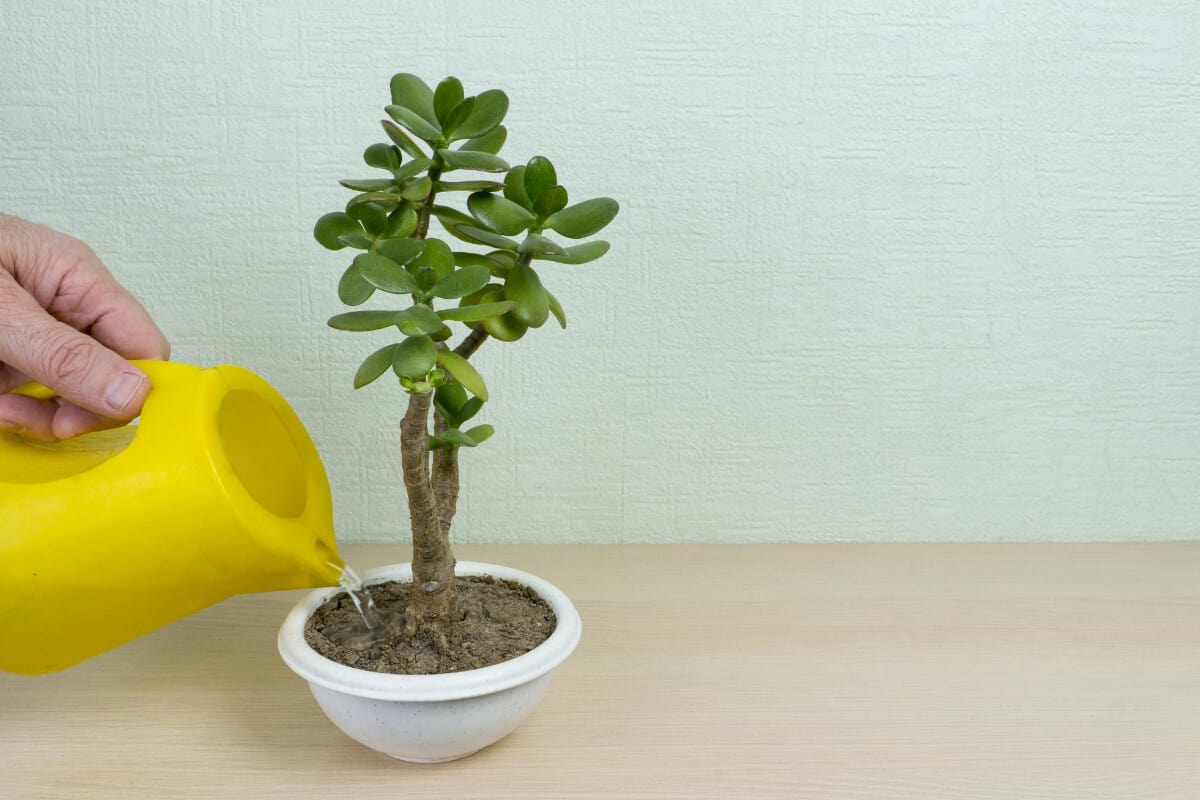Jade plants (Crassula Ovata) are lovely houseplants that historically represent good luck and prosperity. As succulents, they are easy to grow and care for as long as the growing conditions are met.
Jade plants are compact plants that require less maintenance due to their slow growth. However, if environmental conditions are less than ideal, these plants can also become leggy.
Leggy Jade plants can look sparse and unattractive, but luckily it’s relatively easy to fix them.
In this article, we’re going to cover how to fix and prevent leggy Jade plants, and why they become leggy in the first place.
- Related article: Jade Plant Crassula Ovata Guide
Why Does a Jade Plant Get Leggy?

When a jade plant is described as leggy, this means that its branches have stretched. Leggy branches are a sign that a jade plant has insufficient access to sunlight.
Light levels are a necessary component for a Jade plant’s health, including robust growth and reproduction. It is essential to a plant’s process of photosynthesis which provides it with nourishment and energy.
A lack of light will cause a plant to stretch and the leaf nodes become elongated in search of sufficient sunlight. It will also lessen the green color of leaves and stems.
When denied an adequate amount of light, these plants will begin to look thin, scrawny, and generally unhealthy.
This process is called “etiolation” and is the plant’s answer to poor light conditions. The jade plant undertakes this process as a means of survival.
When a jade plant is positioned in inadequate environmental light, it produces phytohormones. This happens during etiolation, which allows the stems to stretch.
The plant will then grow in the direction of the light they perceive. This action of stretching for the light enables the plant to survive, but it also creates that leggy look.
A healthy jade plant usually grows upright with compact, bushy, and dense growth.
Jade plants prefer several hours of direct light daily. They do very well when placed on window sill or near sources of bright sunshine.
- Related article: What Do Jade Plants Look Like?
How to Fix a Leggy Jade Plant
Here are several actions you can undertake to fix your leggy jade plant:
1. Move Your Plant to a New Location
If your plant appears a bit leggy, try moving it to a window sill, or close to a window so that it has direct access to light. Make sure the window, transparent wall, or door you choose gets sufficient daily sunlight.
2. Place Your Jade Plant Outdoors Daily
If you have a space outside you house, you can also consider rotating the position of your plant by alternating through indoors and outdoors.
You can opt to put it on your garden, porch or patio for several days during the week. However, make sure to keep an eye on pests that you might carry back indoors with your plant.
This might be another problem that can arise in the future.
3. Pinch and Prune
It’s simple to prune the leggy stems of your plant. This will not only stimulate denser, bushier growth but improve the aesthetics of the plant as well.
Trim off thin foliage or sickly-looking branches and stems. Thin stems should be pruned as they will not be able to support the weight of fleshy foliage.
4. Install a Grow Light
LED and fluorescent lights provide an excellent alternative to insufficient light. For example, if you live in an apartment without much light and a balcony, consider using a grow light for your houseplants.
This is also a great option if you are cultivating a jade plant in an office setting. They are particularly at risk of becoming leggy in the winter.
You’ll find grow lights available in all sizes to fit any situation and costs for every budget.
5. Reduce the Environmental Temperature
Jade plants will grow more rapidly in warmer climates and temperatures. While its growth will slow down when it’s cold.
If you are having difficulty providing a good light source, move your plant to a cooler location. This will slow the etiolation process.
How to Prune a Leggy Jade Plant

The jade plant is a tree-like plant that potentially will continue to grow taller in the proper environmental conditions. It can grow tall and top-heavy, placing it at risk to fall over one day.
Often, a plant’s single trunk is unable to support the total weight of a top-heavy plant. So, what can we do about this?
Prune your plant to maintain a weight that is evenly distributed. Most jade plants will need to be pruned yearly.
Begin pruning when the plant is still young and smaller in size. This will stimulate your plant to branch out in evenly and will enhance its look to make for a real bushy plant.
Pruning a Small Jade Plant
For plants smaller than 6 inches in height, just top off the trunk. New leaves will sprout from your cut point in a few weeks.
Pruning Tall Jade Plants
Examine your plant closely and search for brown stem rings. These should be located approximately ¼th of an inch from the branch’s end. Cut through the ring with sharp, clean, pruning shears or a garden knife.
Pruning your on a regular basis will make your jade plant bushy and more attractive.
Prune to Encourage Branching
To encourage a bushier and fuller looking plant, you can prune the top of leggy plants up until what is called a leaf scar. The area of a plant that has brown rings around the stem is called a leaf scar. This process will cause the growth of fuller lateral branches.
Also, remove leaves that are sprouting from the trunk. This will stimulate the growth of branches from these points. Never remove more than 2 or 3 leaves at any one time.
Pruning Jade Plants With Few Branches
If your plant has only a few branches, pruning will stimulate denser growth.
This will also help the symmetry of the plant. Pinch off or snip foliage from branch tips. This will encourage denser growth.
Pruning Jade Plants That Are Overgrown
If you have an overgrown jade plant with too many branches, it’s time for pruning. Remove dried-out, diseased, damaged, or dead branches.
Do not cut the main trunk. Remove yellowing, shriveling, or spotted foliage along with other overgrown sections of the plant.
Identify branches growing at unusual angles and trim them off. If branches are congested and blocking sunlight from the trunk, remove excess branches.
Jade Plant Pruning Tips
Pruning Tools for Jade Plants
Use sharp tools that have been properly cleaned and sterilized. Sharp shears or bonsai pruning shears are the recommended choice. By sterilizing them, you avoid spreading disease to your plant.
When to Prune Jade Plants
Prune your jade plant at the beginning of spring before the growing season takes off. This is particularly important for jade plants that are cultivated outdoors.
Save Jade Plant Cuttings
Don’t toss out Jade plant cuttings after pruning. The Jade Plant is easily propagated, so these cuttings can be used for new Jade plants to keep and gift.
Don’t Prune Jade Plants Too Often
Never prune more than one-third of the plant. Cut conservatively. Once you’ve pruned, there’s no going back.
How to Prevent Leggy Jade Plants

A leggy Jade plant is due to inadequate access to sunlight. The best way to prevent your Jade plant from becoming leggy is to guarantee your plant receives sunlight several hours daily.
Place your plant in or near a window to provide natural light. If this is impossible, use an artificial grow light.
Apart from providing access to adequate light, improve your care of the plant. Water your plant on a schedule and add a bit of fertilizer occasionally.
The Jade plant is not a big feeder. Get a fertilizer formulated specifically for succulents and follow the manufacturer’s instructions for application.
Fixing Leggy Jade Plants Final Thoughts
Prevention is always the best solution. it’s better to act early so your Jade plant never becomes leggy.
Provide your jade plant with hours of sunlight. It will reward you with beautiful dense growth that is aesthetically pleasing.
If your Jade plant is already leggy, follow these basic tips to improve your plant’s health and appearance.
To learn more about Jade plants, check out these other articles:
- How Often Does a Jade Plant Bloom?
- Shrek Ears Plant (aka ET’s Fingers Jade Plant)
- Jade Plant Soil Mix

